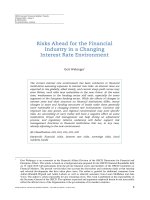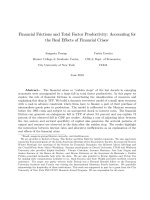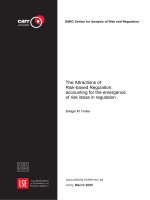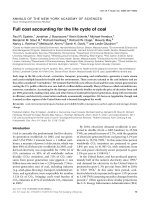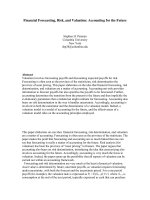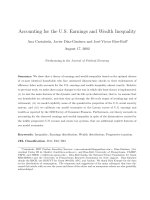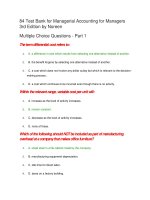Lecture Managerial Accounting for the hospitality industry: Chapter 12 - Dopson, Hayes
Bạn đang xem bản rút gọn của tài liệu. Xem và tải ngay bản đầy đủ của tài liệu tại đây (462.93 KB, 57 trang )
Chapter 12
Capital Investment,
Leasing, and Taxation
© 2009 John Wiley & Sons
Hoboken, NJ 07030
1
Managerial Accounting for the Hospitality Industry
Dopson & Hayes
Chapter Outline
Capital Budgeting
Capital Investment
Financing Alternatives
Taxation
© 2009 John Wiley & Sons
Hoboken, NJ 07030
2
Managerial Accounting for the Hospitality Industry
Dopson & Hayes
Learning Outcomes
Identify the purpose of capital budgeting.
Compute business owners’ investment rates of return.
Identify advantages and disadvantages of capital
financing alternatives such as debt versus equity
financing and lease versus buy decisions.
Determine the effects of taxation on a hospitality
business.
© 2009 John Wiley & Sons
Hoboken, NJ 07030
3
Managerial Accounting for the Hospitality Industry
Dopson & Hayes
Capital Budgeting
In business, capital simply refers to money.
Those who invest their capital are, not surprisingly,
called capitalists, and the economic system that allows
for the private ownership of property is called
capitalism.
As is the case in most industries, investing money in
hospitality businesses can be risky.
Capital budgets are used to plan and evaluate
purchases of fixed assets such land, property, and
equipment.
© 2009 John Wiley & Sons
Hoboken, NJ 07030
4
Managerial Accounting for the Hospitality Industry
Dopson & Hayes
Capital Budgeting
Purchases of this type are called capital expenditures
and, as you learned previously, are recorded on a
business’s balance sheet.
Capital budgeting is the essential process by which
those in business evaluate which hospitality operations
will be started, which will be expanded, and which will
be closed.
In nearly all cases, business owners seek returns on
their investments which are large enough to justify the
continued investment of their capital.
© 2009 John Wiley & Sons
Hoboken, NJ 07030
5
Managerial Accounting for the Hospitality Industry
Dopson & Hayes
Capital Budgeting
In general, capital budgeting techniques can be
classified as those that are directed toward one or more
of the following business activities:
Establish a business (new venture, sometimes
funded by venture capitalists)
Expand a business (increase revenues)
Increase efficiency (reduce expenses)
Comply with the law (mandated change)
© 2009 John Wiley & Sons
Hoboken, NJ 07030
6
Managerial Accounting for the Hospitality Industry
Dopson & Hayes
Capital Investment
Investors seek to balance the concepts of risk, with that
of reward (increase vs. decrease in value).
In most cases, as the amount of risk involved in an
investment increases, the return on that investment also
increases.
As an investor you would ultimately seek to compare
the cost of making an investment today against the
stream of income that the investment will generate in
the future.
To best make this “in the future” value comparison, or
time value of money, which is the concept that money
has different values at difference points in time.
© 2009 John Wiley & Sons
Hoboken, NJ 07030
7
Managerial Accounting for the Hospitality Industry
Dopson & Hayes
Time Value of Money
To illustrate the time value of money concept, assume
that you have won $10,000 in the state lottery. Your
options for collecting payment are:
Receive $10,000 now, or
Receive $10,000 in four years.
If you are like most people, you would choose to receive
the $10,000 now.
It makes little sense to defer (delay) a cash flow into the
future when you could have the exact same amount of
money now.
© 2009 John Wiley & Sons
Hoboken, NJ 07030
8
Managerial Accounting for the Hospitality Industry
Dopson & Hayes
Time Value of Money
From an investment perspective, those in business
know you can do much more with money if you have it
now because you can earn even more money through
wise investments.
The value of the money that is invested now at a given
rate of interest and grows over time is called the future
value of money. The process of money earning interest
and growing to a future value is called compounding.
See Go Figure! for an illustration of this.
© 2009 John Wiley & Sons
Hoboken, NJ 07030
9
Managerial Accounting for the Hospitality Industry
Dopson & Hayes
g o fig u re!
To see why this is so, consider Rhonda and Ron. Both are owed $1,000. Rhonda
collects the money owed to her on January 1st while Ron collects the $1,000 owed to
him on December 31st of the same year.
After thoroughly evaluating her investment opportunities, Rhonda takes her money on
January 1st and invests it in a company that will pay her a 10% annual rate of return. As
a result, on December 31st Rhonda would have $1,100 as shown using the total
investment value formula as follows:
Investment + Return on Investment = Total Investment Value
or
$1,000 + ($1,000 X 0.10) = $1,100
As a result of her investment, at the end of the year, Rhonda’s $1000 is now worth
$1,100, while Ron’s $1000 is, of course, still worth only $1,000.
Now, assume that Rhonda elects to re-invest her original $1,000 and all of her
investment earnings. If she does so, Rhonda is poised to increase the future value of her
money even further by earning investment returns over an even longer period of time.
The value of the money that is invested now at a given rate of interest and grows over
time is called the future value of money. The process of money earning interest and
growing to a future value is called compounding.
If Rhonda maintained her investment for four years, it would grow as follows:
© 2009 John Wiley & Sons
Hoboken, NJ 07030
Year 1
$1,000 + ($1,000 X 0.10) = $1,100
Year 2
$1,100 + ($1,100 X 0.10) = $1,210
Year 3
$1,210 + ($1,210 X 0.10) = $1,331
Year 4
$1,331 + ($1,331 X 0.10) = $1,464
10
Managerial Accounting for the Hospitality Industry
Dopson & Hayes
g o fig u re!
The formula managerial accountants use to quickly compute the future value of an
investment when the rate of return and length of the investment is known is as follows:
Future Value = Investment Amount X (1 + Investment Earnings %) n
or
FVn = PV x (1+i)n
Where FV equals the amount of the investment at the end of the investment period
(future value), PV equals the present value of the investment, n equals the number
of years the investment will be maintained, and i equals the interest rate %.
In the example of Rhonda’s four-year investment, the future value formula would be
computed as:
$1,000 X (1 + 0.10)4 = Future Value
or
$1,000 X (1.464) = $1,464
© 2009 John Wiley & Sons
Hoboken, NJ 07030
11
Managerial Accounting for the Hospitality Industry
Dopson & Hayes
Time Value of Money
The effect of a compound investment earning 10%
annual returns is summarized below.
Figure 12.2 Effect of Compound Investment Returns
Value
Year 1
Year 2
Year 3
Year 4
Beginning Value
$1,000
$1,100
$1,210
$1,331
100
110
121
133
$1,100
$1,210
$1,331
$1,464
Investment Earnings
Year End Total Investment Value
© 2009 John Wiley & Sons
Hoboken, NJ 07030
12
Managerial Accounting for the Hospitality Industry
Dopson & Hayes
Time Value of Money
When a future value is known, then the present value,
or the amount the future value of money is worth today,
can be determined.
The process of computing a present value is called
discounting, or calculating the value of future money
discounted to today’s actual value.
See Go Figure! for an illustration of this.
© 2009 John Wiley & Sons
Hoboken, NJ 07030
13
Managerial Accounting for the Hospitality Industry
Dopson & Hayes
( g o fig u re! continued)
When a future value is known, then the present value, or the amount the future value of
money is worth today, can be determined. The process of computing a present value is
called discounting, or calculating the value of future money discounted to today’s actual
value. The formula managerial accountants use to quickly compute the present value of
an investment when the rate of return and length of the investment is known is as
follows:
Present Value =
Future Value
(1 + Investment Earnings %)n
or
PV =
FVn
(1 + i)n
Where FV equals the amount of the investment at the end of the investment period
(future value), PV equals the present value of the investment, n equals the number
of years the investment will be maintained, and i equals the interest rate %.
In the example of Rhonda’s four-year investment, the present value formula would be
computed as:
$1,464
(1 + 0.10)4
= Present Value
or
$1,464
1.464
= $1,000
Put another way, Rhonda’s $1,464 investment (received four years from now) would be
worth $1,000 today.
© 2009 John Wiley & Sons
Hoboken, NJ 07030
14
Managerial Accounting for the Hospitality Industry
Dopson & Hayes
Time Value of Money
Future values and present values can be calculated
using the formulas stated in this chapter, time value of
money tables, and/or financial calculators.
As you (and all savvy investors) now recognize,
maximum returns on money invested (ROI) are
achieved by utilizing one or both of the following
investment strategies:
1. Increasing the length of time money is invested
2. Increasing the annual rate of return on the
investment
© 2009 John Wiley & Sons
Hoboken, NJ 07030
15
Managerial Accounting for the Hospitality Industry
Dopson & Hayes
Rates of Return
Before closely examining rates of return, it is very
important for those in the hospitality industry (as well as
all other industries!) to understand that operating profits
are not the same as return on investment.
Sometimes, a restaurant that achieves a very good
profit (net income) is still not a good investment for the
restaurant’s owner.
In other cases, a restaurant that achieves a less
spectacular net income is a better investment.
See Go Figure! for an illustration of this.
© 2009 John Wiley & Sons
Hoboken, NJ 07030
16
Managerial Accounting for the Hospitality Industry
Dopson & Hayes
g o fig u re!
For example, assume two restaurant owners have generated $200,000 in net income
after a year of operating their respective restaurants. The first owner invested
$2,000,000 in the operation, and the second owner invested $4,000,000.
Using the ROI formula you learned about in Chapter 3, the owners’ ROIs can be
calculated as follows:
Money Earned on Funds Invested
Funds Invested
= ROI
or
First Owner:
$200,000
$2,000,000
= 10%
Second Owner:
$200,000
$4,000,000
© 2009 John Wiley & Sons
Hoboken, NJ 07030
17
= 5%
Managerial Accounting for the Hospitality Industry
Dopson & Hayes
Rates of Return
Actual returns on investment can vary greatly, but few, if
any, investors will for a long period of time invest in a
restaurant if the net income is less than what could be
achieved in other investment opportunities with the
same or lesser risks.
Sophisticated managerial accountants can utilize
several variations of the basic ROI formula to help them
make good decisions about investing their capital.
For working managers interested in maximizing returns
on investment, two of the most important of these
formula variations are:
Savings Rate of Return
Payback Period
© 2009 John Wiley & Sons
Hoboken, NJ 07030
18
Managerial Accounting for the Hospitality Industry
Dopson & Hayes
Savings Rate of Return
The savings rate of return is the relationship between
the annual savings achieved by an investment and the
initial capital invested.
An example of this information based on Amy Sussums,
a country club manager who is contemplating the
purchase of a new dish machine, is presented in Figure
12.4 and the following Go Figure! exercise.
In many cases, managerial accountants and/or the
owners of a business will set an investment return
threshold (minimum rate of return) that must be
achieved prior to the approval of a capital expenditure.
© 2009 John Wiley & Sons
Hoboken, NJ 07030
19
Managerial Accounting for the Hospitality Industry
Dopson & Hayes
Figure 12.4 Country Club Dish Machine Cost Analysis
Current Dish Machine
Proposed New Dish Machine
Book Value = $8,000
Cost is $22,000 installed
Expected machine life is three years
Expected machine life is fifteen years
Current value (if sold) is $3,000
Value (if sold) in 15 years is $ 0.
Annual operating costs are $ 41,200
Annual operating costs are $31,000
due to the machines fewer labor hours
required and increased energy
efficiency
© 2009 John Wiley & Sons
Hoboken, NJ 07030
20
Managerial Accounting for the Hospitality Industry
Dopson & Hayes
g o fig u re!
Based on the information Amy has gathered:
The new machine costs $22,000 (installed) and the value of the old machine is
$3,000.
Thus, the new capital required to be invested in the machine would be $19,000
($22,000 - $3,000 = $19,000).
Amy will achieve cost savings of $10,200 per year ($41,200 to operate the old
machine - $31,000 to operate the new machine = $10,200 annual savings).
She can compute her savings rate of return as follows:
Annual Savings
Capital Investment = Savings Rate of Return
or
$10,200
$19,000 = 53.7%
© 2009 John Wiley & Sons
Hoboken, NJ 07030
21
Managerial Accounting for the Hospitality Industry
Dopson & Hayes
Payback Period
Payback period refers to the length of time it will take to
recover 100% of an amount invested.
Typically, the shorter the time period required to recover
all of the investment amount, the more desirable it is.
Managerial accountants often utilize the payback period
formula to evaluate different investment alternatives.
See Go Figure! for an illustration of this.
© 2009 John Wiley & Sons
Hoboken, NJ 07030
22
Managerial Accounting for the Hospitality Industry
Dopson & Hayes
g o fig u re!
In the dish machine example cited in Figure 12.4, Amy would compute her payback
period as:
Capital Investment
Annual Income (or Savings) = Payback Period
or
$19,000
$10,200
© 2009 John Wiley & Sons
Hoboken, NJ 07030
23
= 1.86 years (approximately 1 year and 10 months)
Managerial Accounting for the Hospitality Industry
Dopson & Hayes
Capitalization Rates
In most cases, business investors are not guaranteed a
return on their investments.
Investment returns typically increase as an investment’s
risk level increases.
To fully appreciate how business investors estimate
their ROIs and then consider risk levels, you must first
understand capitalization rates.
In the hospitality industry, capitalization (cap) rates are
utilized to compare the price of entering a business (the
investment) with the anticipated, but not guaranteed,
returns from that investment (net operating income).
© 2009 John Wiley & Sons
Hoboken, NJ 07030
24
Managerial Accounting for the Hospitality Industry
Dopson & Hayes
Capitalization Rates
This ties investment returns to:
The size of the profits (net operating income)
generated by the business
The size of the investment in the business
Net operating income (NOI), in general, is the income
before interest and taxes you would find on a restaurant
or hotel income statement.
Investors generally do not want to pay more than the
true value of any specific hospitality business or
property they are considering purchasing.
See Go Figure! for an illustration of this.
© 2009 John Wiley & Sons
Hoboken, NJ 07030
25
Managerial Accounting for the Hospitality Industry
Dopson & Hayes

